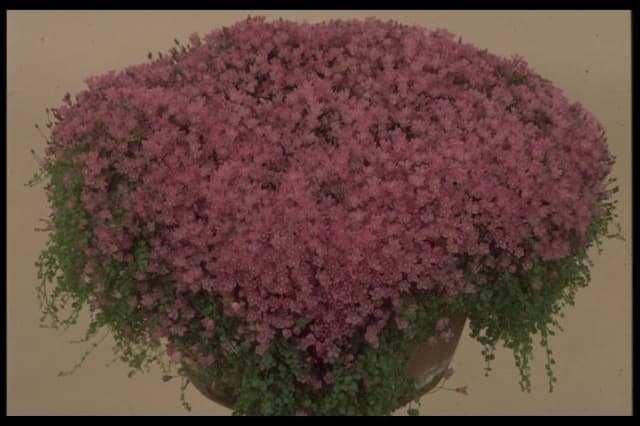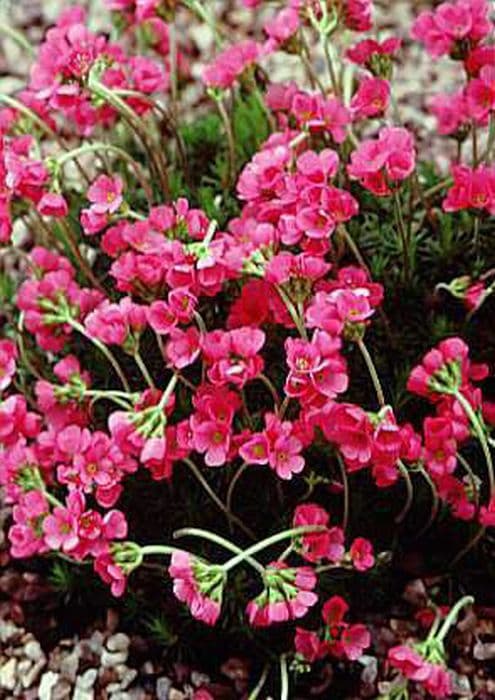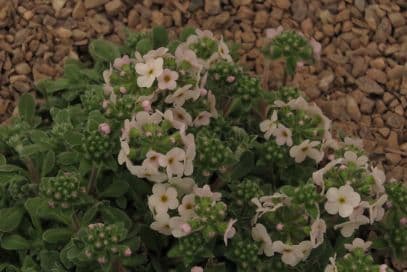Primrose Primula 'Crescendo Golden' (Crescendo Series) (Pr/poly)

ABOUT
Primula 'Crescendo Golden', belonging to the Crescendo Series, is a striking plant that captivates with its vibrant golden-yellow flowers. The blooms are characterized by a round shape with a slightly ruffled edge, providing a cheerful and robust display that can brighten up any garden space. Clustered at the center of each flower is a small, eye-catching cluster of stamens that add to the ornamental appeal of the plant. The foliage of Primula 'Crescendo Golden' is also noteworthy, featuring a rosette arrangement of lush green leaves. The leaves are oval to oblong in shape, with a texture that can range from smooth to slightly crinkled, creating a lush backdrop for the brilliant flowers. The overall appearance of Primula 'Crescendo Golden' is one of vivid color and compact, rounded growth that offers a splash of sunshine wherever it's planted.
About this plant
 Names
NamesFamily
Primulaceae
Synonyms
English Primrose, Common Primrose
Common names
Primula 'Crescendo Golden' (Crescendo Series) (Pr/poly)
 Toxicity
ToxicityTo humans
The plant commonly known as Primrose is generally not considered highly toxic to humans. However, some people may experience mild irritation or an allergic reaction if they have sensitive skin or allergies. In rare cases, ingestion can cause nausea or stomach upset. It's advisable to avoid eating any part of this plant.
To pets
The Primrose plant may have toxic effects on pets if ingested. Cats and dogs could experience mild to moderate gastrointestinal upset, such as vomiting or diarrhea, after consuming parts of this plant. If you suspect your pet has ingested Primrose, it is best to consult a veterinarian.
 Characteristics
CharacteristicsLife cycle
Perennials
Foliage type
Evergreen
Color of leaves
Green
Flower color
Yellow
Height
6-8 inches (15-20 cm)
Spread
6-8 inches (15-20 cm)
Plant type
Herb
Hardiness zones
5-9
Native area
Not specified
Benefits
 General Benefits
General Benefits- Attractive Blooms - Features vibrant, yellow flowers that can add a bright pop of color to garden beds and containers.
- Long Blooming Period - Often has an extended flowering period, providing visual interest over several weeks or months.
- Easy to Grow - Typically low maintenance, making it a good choice for novice gardeners or those with limited time.
- Cold Tolerant - Can survive in cooler temperatures, making it suitable for gardens in temperate climates.
- Compact Size - Grows in a compact form, which is ideal for small spaces or as a border plant.
- Attracts Pollinators - The flowers can attract bees and butterflies, supporting local biodiversity.
- Versatile Usage - Suitable for use in garden beds, borders, pots, and as part of a mixed display.
- Seasonal Interest - Adds color in the spring and early summer, a time when many other plants are not yet in bloom.
- Propagation Potential - Can be propagated from seeds or by division, allowing gardeners to create more plants over time.
 Medical Properties
Medical PropertiesThis plant is not used for medical purposes.
 Air-purifying Qualities
Air-purifying QualitiesThis plant is not specifically known for air purifying qualities.
 Other Uses
Other Uses- Photography Subject: The vibrant yellow flowers of Primula Crescendo make it an excellent subject for photographers, especially those who specialize in macro or nature photography.
- Companion Planting: Gardeners may use Primula Crescendo in companion planting to attract beneficial insects that pollinate other plants or provide a natural contrast amid green foliage.
- Educational Tool: Botany educators may use Primula Crescendo to teach students about plant life cycles, pollination, and the care of perennials.
- Crafts: The flowers can be dried and used in craft projects, such as creating natural potpourri, or decorating eco-friendly greeting cards and bookmarks.
- Theme Gardens: These flowers can be featured in a yellow-themed garden or a moonlight garden, where their light petals can be appreciated under the moonlight.
- Color Dye: The petals can potentially be used to create natural dyes for fabrics, though this isn't a typical use, experimentation could yield interesting results.
- Garden Art: Primula Crescendo can be planted strategically to create living garden art, taking advantage of its vibrant color to form patterns or designs in the landscape.
- Children's Gardens: Their bright color and ease of growing make Primula Crescendo suitable for children's gardens, helping to spark an interest in horticulture from a young age.
- Culinary Garnish: While not traditionally used for eating, the flowers may serve as an organic garnish to decorate cakes or salads after ensuring they are safe and pesticide-free.
- Floral Arrangements: The flowers can contribute a pop of color to floral arrangements, including being floated in bowls of water for a simple and elegant display.
Interesting Facts
 Feng Shui
Feng ShuiThe Primrose is not used in Feng Shui practice.
 Zodiac Sign Compitability
Zodiac Sign CompitabilityThe Primrose is not used in astrology practice.
 Plant Symbolism
Plant Symbolism- Hope: Primula, also known as primrose, often blooms early in spring, symbolizing hope and the anticipation of things to come.
- Youth: Its bright flowers are reminiscent of youth and vitality, representing freshness and the spirit of youthfulness.
- Renewal: With its early spring bloom, the primrose is a herald of renewal, representing new beginnings and the cycle of life.
- Love: In some traditions, primroses are given as a symbol of love and affection, especially young love.
 Water
WaterPrimula 'Crescendo Golden' prefer to be kept in moist soil without being waterlogged, so it’s important to water them deeply but allow the top inch of soil to dry out between waterings. Depending on the humidity and temperature, this may mean watering once or twice a week. Generally, a good approach is to provide water when the top inch of the soil feels dry to the touch. For a potted plant, you might water with approximately 16 ounces per week, adjusting based on the plant's response and environmental conditions.
 Light
LightPrimula 'Crescendo Golden' thrives best in bright, indirect light but can tolerate partial shade as well. They should be placed in a spot where they will be protected from the harsh midday sun, which could damage the delicate flowers and foliage. An ideal location would be an east or north-facing window or a spot that receives filtered sunlight.
 Temperature
TemperatureThe ideal temperature range for Primula 'Crescendo Golden' is between 50°F and 75°F. They can survive minimum temperatures down to around 20°F, but it's not advisable for prolonged periods. To ensure robust growth, try to keep them in a location that avoids extremes and where nighttime temperatures don’t drop below 40°F.
 Pruning
PruningPrimula 'Crescendo Golden' benefit from deadheading, which means removing spent flowers to encourage more blooms and prevent energy being wasted on seed production. Lightly prune right after flowering to tidy up the plant and stimulate new growth. Annual pruning is often enough, but regular deadheading can be done throughout the blooming period.
 Cleaning
CleaningAs needed
 Soil
SoilThe ideal soil mix for Primula Crescendo, commonly known as Polyanthus, should be rich, well-draining, and consistently moist. A blend of loamy soil, peat, and perlite or sand works well to retain moisture yet allow excess water to escape, preventing root rot. The best soil pH for Polyanthus is slightly acidic to neutral, ranging between 6.0 and 7.0.
 Repotting
RepottingPolyanthus, should be repotted every 1-2 years to replenish the soil and give room for growth. It is best to repot these plants in the spring before they enter their active growing season, using a fresh soil mix that matches the preferred conditions of the plant.
 Humidity & Misting
Humidity & MistingPolyanthus thrives in conditions with average to high humidity levels. It is best grown in an environment with a humidity level of around 50-60%. Avoid placing it in locations with dry air that can lead to stress and possible foliage damage.
 Suitable locations
Suitable locationsIndoor
Place in bright, indirect light, ensure high humidity, and keep soil moist.
Outdoor
Plant in partial shade, in rich, moist, well-drained soil.
Hardiness zone
5-9 USDA
 Life cycle
Life cycleThe Primula 'Crescendo Golden', commonly known as Polyanthus, begins its life cycle when the seeds are sown in moist, well-draining soil during late winter or early spring. Upon germination, the seedlings grow and develop a rosette of leaves at a juvenile stage, during which they establish a strong root system. As the plant matures, it enters a vegetative stage, producing larger and more numerous leaves, followed by the development of a flowering stem. The Polyanthus reaches its reproductive stage in early spring when it produces bright golden-yellow flowers that are arranged in dense, umbel-like clusters. After pollination, typically facilitated by insects, the flowers develop into small capsules containing seeds, completing the generative phase. Eventually, the plant may enter a period of dormancy, especially in regions with cold winters, retreating to the rosette stage until favorable growth conditions return.
 Propogation
PropogationPropogation time
Spring to Summer
Propogation: The most popular method of propagating Primula 'Crescendo Golden', commonly known as the Primrose, is by division. This process is best done in the late summer after the flowering period has ended or in early fall. To propagate by division, carefully lift the parent plant from the ground and use a sharp, sterilized knife or spade to divide the plant into smaller sections, ensuring each section has a good amount of roots and at least one or two healthy leaves. Replant the divisions promptly into well-draining soil at the same depth they were growing previously and water thoroughly. It is crucial to keep the soil moist but not waterlogged to encourage root development. After a few weeks, the divisions should establish themselves and start growing into new, independent plants.









